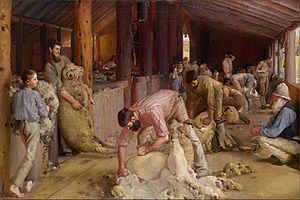
Back مدرسة هايدلبرغ Arabic Escola de Heidelberg Catalan Heidelberg School German Escuela de Heidelberg Spanish مکتب هایدلبرگ Persian Heidelberg School French אסכולת היידלברג HE Հեյդելբերգի դպրոց Armenian ハイデルバーグ派 Japanese Heidelberg School Polish


The Heidelberg School was an Australian art movement of the late 19th century. It has been described as Australian impressionism.[1]
Melbourne art critic Sidney Dickinson coined the term in an 1891 review of works by Arthur Streeton and Walter Withers, two local artists who painted en plein air in Heidelberg on the city's rural outskirts. The term has since evolved to cover these and other painters—most notably Tom Roberts, Charles Conder and Frederick McCubbin—who worked together at "artists' camps" around Melbourne and Sydney in the 1880s and 1890s. Drawing on naturalist and impressionist ideas, they sought to capture Australian life, the bush, and the harsh sunlight that typifies the country.
The movement emerged at a time of strong nationalist sentiment in the Australian colonies, then on the cusp of federating. The artists' paintings, like the bush poems of the contemporaneous Bulletin School, were celebrated for being distinctly Australian in character, and by the early 20th century, critics had come to identify the movement as the beginning of an Australian tradition in Western art. Many of their major works can be seen in Australia's public galleries, including the National Gallery of Australia, the National Gallery of Victoria and the Art Gallery of New South Wales.
- ^ "Introduction to Australian Impressionism". Australian Impressionism. Melbourne: National Gallery of Victoria. Archived from the original on 17 March 2011. Retrieved 23 January 2023.
© MMXXIII Rich X Search. We shall prevail. All rights reserved. Rich X Search